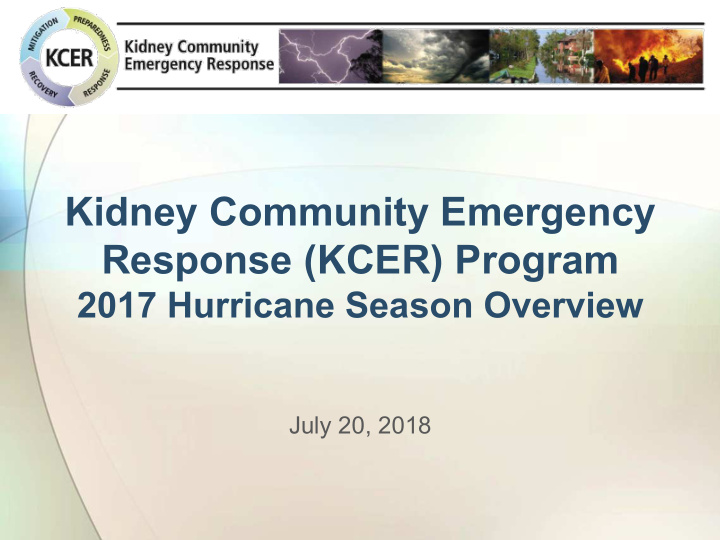



Kidney Community Emergency Response (KCER) Program 2017 Hurricane Season Overview July 20, 2018
Overview • Provide an overview of the KCER Program’s role during the 2017 Hurricane Season. • Discuss the impact of the season on the ESRD community. • Share best practices and lessons learned that were identified from the experience. • Review the progress of ongoing recovery efforts in the impacted areas. 2
Emergency Response Activities • KCER convened and coordinated national stakeholders to discuss how the ESRD community was being impacted and identify challenges or un-met needs. • KCER supported Networks, providers, and patients, by tracking facility operational status, connecting stakeholders with resources to help meet un-met needs, and through the Helpline. • KCER partnered with multiple stakeholders to address barriers related to patient safety and access to care, including working with providers to obtain the critical supplies needed for providing treatment. 3
2017 Hurricane Season • Hyperactive, deadly, and extremely destructive § Season featured multiple category 5 hurricanes • Fifth most active season on record § 17 named storms § 10 hurricanes occurred in a row § Highest number of major storms since 2005 • The costliest season on record § Nearly all costs due to three of the season’s major hurricanes—Harvey, Irma, and Maria § Nearly twice the cost of damages recorded in 2005 4
Hurricane Harvey August 23, 2017 Hurricane Harvey regenerates in the Gulf of Mexico August 24, 2017 Hurricane warnings issued for Texas Coast August 25, 2017 Initial landfall on San Jose Island August 26, 2017 Second landfall on northeastern shore of Copano Bay August 27–August 29, 2017 Harvey hovers over Texas Coast, moving slowing southeast towards Houston. Catastrophic flooding occurs across southeast Texas. August 30, 2017 Third and final landfall, just west of Cameron, Louisiana 5
Hurricane Harvey— ESRD Impact Texas • More than 14,000 patients impacted • More than 260 facilities impacted § Nine received damage resulting in long-term closures § Three remain closed to date 6
Hurricane Harvey— Lessons Learned Challenges Best Practices • Duration of the storm • Special Purpose Renal Dialysis Facility (SPRDF) Approval • Patients who did not evacuate – resulting in • Volunteer group to triage the need for rescue patient needs via phone • The number of facilities • Large Dialysis Organizations impacted at once in a sent personnel to Texas to concentrated area assist with rescuing patients and getting them treatment. • Long-term displacement of patients 7
Hurricane Irma August 31, 2017 Tropical Storm Irma forms in the South Atlantic September 4, 2017 Hurricane warnings issued for U.S. Virgin Islands and Puerto Rico September 6, 2017 Irma makes landfall in the U.S. Virgin Islands and Puerto Rico September 8, 2017 Hurricane warnings issued for Florida September 10, 2017 Irma makes landfall in Florida 8
Hurricane Irma—ESRD Impact U.S. Virgin Islands • 240 patients impacted § 120 patients from St. Thomas evacuated to Puerto Rico on September 9–10, 2017 • Four facilities impacted § Two facilities on St. Thomas received extensive damage and remain closed to date Puerto Rico • 6,000 patients impacted • 48 facilities impacted Florida • 30,430 patients impacted • 449 facilities impacted 9
Hurricane Irma—Lessons Learned Challenges Best Practices • Track changed quickly • Print copies of patient and staff contact information • Entire state impacted • Post alternative facility • Facilities closed too soon information on closed • Duplication of reporting facility door/window efforts • Review hurricane packet • Hepatitis B status with each patient at last unknown treatment prior to the • Facility voicemails not storm updated 10
Hurricane Maria September 16, 2017 Hurricane Maria forms in the Western Atlantic Ocean September 18, 2017 Hurricane warnings issued for U.S. Virgin Islands and Puerto Rico September 20, 2017 Landfall in U.S. Virgin Islands and Puerto Rico 11
Hurricane Maria—ESRD Impact U.S. Virgin Islands • Out of 120 St. Thomas patients, 84 evacuated from Puerto Rico to Miami on September 19, 2017 • 96 patients from St. Croix evacuated to Atlanta, Georgia, from September 24–30, 2017 • Two facilities on St. Croix received extensive damage and remain closed to date Puerto Rico • Over 6,000 patients impacted • More than 400 patients self- evacuated to the mainland • Out of 48 facilities, three facilities remain closed to date 12
Hurricane Maria—Incident Response • Disruptions in infrastructure resulted in: § Ongoing community-wide rescue/recovery due to the major flooding § 911 system was overloaded § Transportation was affected by roads, private/public services suspended § Power/water supplies affected by flooding § Disrupted provision of dialysis due to closed or altered operations within dialysis providers § Dialysis supplies for both providers and self/home-care patients were disrupted 13
Hurricane Maria—Lessons Learned Challenges Best Practices • Scarce resources and • Pre-established contacts supplies needed to bring at the local Emergency facilities operational Operations Center • Lack of basic supplies for • SPRDF approval daily living and for conducting home treatments • Influx of evacuated patients into Florida • Lack of identification • Long-term displacement 14
Recovery Activities • KCER continues to submit weekly reports to CMS that provide status updates and situational changes for all impacted areas. • KCER communicates with the impacted ESRD Networks frequently to monitor reopening of facilities reporting long-term closures. • KCER tracks facility location for patients who were displaced or evacuated, or whose facility is closed long-term. 15
@KCERProgram www.facebook.com/KCERCoalition 16
Thank you for joining us today! www.KCERCoaltion.com KCERInfo@hsag.com @KCERProgram www.facebook.com/KCERCoalition www.twitter.com/KCERProgram This material was prepared by the Kidney Community Emergency Response (KCER) contractor, under contract with the Centers for Medicare & Medicaid Services (CMS), an agency of the U.S. Department of Health and Human Services. The contents presented do not necessarily reflect CMS policy nor imply endorsement by the U.S. Government. CMS Contract #: HHSM-500-2006-00007C Publication Number: FL-KCER-7K1T7B-07192018-01 17
Recommend
More recommend